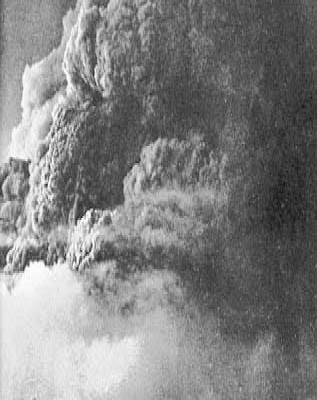On May 8, 1902, Ascension Day, a volcanic eruption destroyed the town of Saint-Pierre, about 6.4 kilometres (4.0 mi) south of the summit.
In the morning, people were observing the fireworks the mountain was displaying. The night shift telegraph operator was sending the reports of the volcanos activity to the operator at Fort-de-France, claiming no significant new developments; his last transmission was at 7:52 was Allez, handing over the line to the remote operator. In the next second, the telegraph line went dead. A cable repair ship had the city in direct view; the upper mountainside ripped open and a dense black cloud shot out horizontally. A second black cloud rolled upwards, forming a gigantic mushroom cloud and darkening the sky in a 50-mile (80 km) radius. The initial speed of both clouds was later calculated to be over 670 kilometres (420 mi) per hour. The horizontal pyroclastic surge hugged the ground and sped down towards the city of Saint-Pierre, appeared black and heavy, glowing hot from the inside. It consisted of superheated steam and volcanic gases and dust, with temperatures exceeding 1,075 deg;C (1,967 deg;F). In under a minute it reached and covered the entire city, instantly igniting everything flammable with which it came in contact.
A rush of wind followed, this time towards the mountain. Then came a half-hour downpour of muddy rain mixed with ashes. For the next several hours, all communication with the city was severed. Nobody knew what was happening, nor who had authority over the island, as the governor was unreachable and his status unknown.
There are unnamed eyewitnesses to the eruption, probably survivors on the boats at the time of the eruption. One eyewitness said the mountain was blown to pieces, there was no warning, while another said it was like a giant oil refinery.One person even went as far to say that the town vanished before our eyes.
The area devastated by the pyroclastic cloud covered about 8 square miles (21 km2), with the city of Saint-Pierre taking the brunt of the damage.
At the time of the eruption, Saint-Pierre had a population of about 28,000, which had swollen with refugees from the minor explosions and mud flows first emitted by the volcano. Legend has previously reported that out of the 30,000 in the city, there were only two survivors: Louis-Auguste Cyparis, a felon held in an underground cell in the town's jail for wounding a friend with a cutlass, and LCompegrave;re-L&ampeacute;andre, a man who lived at the edge of the city. In reality, there were a number of survivors who made their way out of the fringes of the blast zone. Many of these survivors were horribly burned, and some died later from their injuries. A number made their way to Le Carbet, just south of St. Pierre behind a ridge that protected that town from the worst of the pyroclastic flow; survivors were rescued on the beach there by Martinique officials.


 english
english deutsch
deutsch russian
russian ukrainian
ukrainian
Комментарии запрещенны